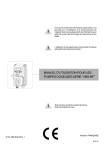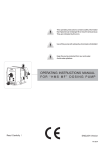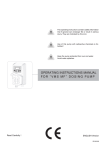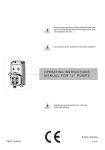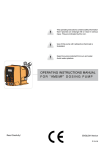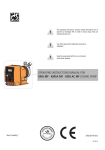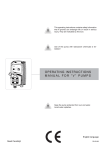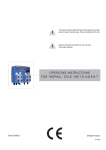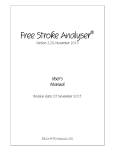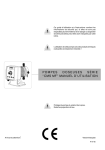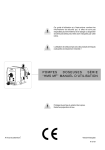Download OPERATING INSTRUCTIONS MANUAL FOR “CMS MF
Transcript
This operating instructions contains safety information that if ignored can endanger life or result in serious injury. They are indicated by this icon. Use of this pump with radioactive chemicals is forbidden! Keep the pump protected from sun and water. Avoid water splashes. OPERATING INSTRUCTIONS MANUAL FOR “CMS MF” DOSING PUMP ENGLISH Version Read Carefully ! 1 R2-01-07 “CMS MF” series solenoid dosing pumps comply with the following European regulations: EN60335-1 : 1995, EN55014, EN50081-1/2, EN50082-1/2, EN6055-2, EN60555,3 Based on directive CEE 73/23 c 93/68 (DBT Low voltage directive) and directive 89/ 336/CEE (EMC Electromagnetic Compatibility) GENERAL SAFETY GUIDELINES Danger! In emergencies the pump should be switched off immediately! Disconnect the power cable from the power supply! When using pump with aggressive chemicals observe the regulations concerning the transport and storage of aggressive fluids! When installing always observe national regulations! Manufacturer is not liable for any unauthorized use or misuse of this product that may cause injury, damage to persons or materials. Caution! Pump must be accessible at all times for both operating and servicing. Access must not be obstructed in any way! Feeder should be interlocked with a no-flow protection device. Pump and accessories must be serviced and repaired by qualified and authorized personnel only! Always discharge the liquid end before servicing the pump! Empty and rinse the liquid end before work on a pump which has been used with hazardous or unknown chemicals! Always read chemical safety datasheet! Always wear protective clothing when handling hazardous or unknown chemicals! 2 1. Introduction Introduction: Metering Pumps “CMS MF” Series are the ideal solution for low / middle dosing of chemicals. All control and setup parameters are available through a digital keyboard and they are displayed on a LCD backlit display. Pump has: “Standby” input, “SEFL” input, “LEVEL” input and “Alarm” (contact) output. Note: “SEFL” not included. Pump’s capacity Flow rate is determined by the stroke length and by the stroke speed. The stroke length is adjustable from 0 to 100% using the stroke length adjustment knob. However dosing accuracy is guarantee within an adjustment range from 30% to 100%. Working modes: Pump can work in differents ways. See related chapters for extended description of each single mode. CONSTANT mode. Pump doses at a constant rate set in “SPH” (strokes for hour), “SPM” (strokes for minute) or “LPH” (litres per hour) parameters set during program session. DIVIDE mode. External pulses from a water meter are divided by a value set during program session. The pump doses with a rate determined by this parameter. MULTIPLY mode. External pulses from a water meter are multiplied by a value set during program session. The pump doses with a rate determined by this parameter. PPM mode. Dosing rate is determined by pulses from a water meter on the base of set PPM, chemical product concentration (%) and quantity for each single stroke set during program session. PERC mode Dosing rate is determined by pulses from a water meter on the base of set PERC (%), chemical product concentration (%) and quantity for each single stroke set during program session. MLQ mode Dosing rate is determined by pulses from a water meter on the base of set MLQ (milliliters per quintal), chemical product concentration (%) and quantity for each single stroke set during program session. BATCH mode. Signal from an external contact starts the pump to dose the set quantity. VOLT mode. Voltage from an external device drives the pump that doses proportionally using a minimum and maximum of strokes for minute set during program session. mA mode. Current from an external device drives the pump that doses proportionally using a minimum and maximum of strokes for minute set during program session. 3 2. Unpacking Included into package: n.4 n.4 n.1 n.1 n.1 n.1 m2 m2 m2 m 2,5 n.1 Dibbles ø6 Self tapping screws 4,5 x 40 Delayed fuse 5 X 20 Foot filter with valve Injection valve Level probe Delivery pipe* (opaque PE) Suction pipe * (transparent PVC) Discharge pipe (transparent PVC) Signal cable for “Stand-by” and “Alarm” This installation manual * If hose is 6x8 there is only a 4meters long hose. Cut to obtain suction and delivery hoses. Remove the contents from the box. PLEASE DO NOT TRASH PACKAGING. IT CAN BE USED TO RETURN THE PUMP. 4 **See page 13 for “Stand-by” and “Alarm” connections. * Note:if knob isn’t on 100% position then the pump will dose at pressure greater than the one declared on label. * Stroke length Knob LCD Display Activity / Power Led ** “Stand-by” and “Allarm” connections to power supply External Signal input Level probe input “SEFL” Input Suction valve to discharge hose Discharge knob Pump head Delivery valve 3. Pump’s description 5 4. Before to Install warnings Pump’s installation and operativity is made in 4 main steps: Pump’s installation Hydraulic Installation (hoses, level probe, injection valve) Electrical Installation (main power connection, SEFL installation, priming) Programming the pump. Before to start, please read carefully the following safety information. Protective clothes Wear always protective clothes as masks, gloves, safety glasses and further security devices during ALL installation procedure and while handling chemicals. Installation location Pump must be installed in a safety place and fixed to the table / wall to avoid vibration problems! Pump must be installed in a easy accessible place! Pump must be installed in horizontal position! Avoid water splashes and direct sun! Hoses and Valves Suction and delivery hoses must be installed in horizontal position! All hoses connections must be performed using only hands’ force! No tongs required! Delivery hose must be firmly fixed to avoid suddenly movements that could damage near objects! Suction hose must be shorter as possible and installed in vertical position to avoid air bubbles suction! Use only hoses compatibles with product to dose! See chemical compatibility table at page 49. If dosing product is not listed please consult full compatibility table or contact chemical’s manufacturer! 6 5. Installation Draw Pump must be installed in a stable support (for example a table) at a maximum height (from tank’s bottom) of 1,5 meters. 4 3 1 8 2 9 5 6 7 1 - Dosing Pump 2 - Suction Hose 3 - Delivery Hose 4 - Injection Valve 5 - Air discharge 6 - Level Probe 7 - Foot Filter 8 - Power Cable 9 - Standby / Alarm 7 6. Hydraulic Installation Hydraulic connections are: Suction Hose with level probe and foot filter Delivery Hose with injection valve Discharge Hose Suction Hose. Completely unscrew tightening nut from pump’s head and remove assembling components: tightening nut, holding ring and pipe holder. Assembly as shown in fig. (A). Insert hose into pipe holder until it reaches the bottom. Lock hose on pump’s head by screwing down the tightening nut. Use only hands to do it! Connect other side of the hose to the foot filter using the same procedure. Suction Hose Tightening Nut Holding Ring Pipe Holder O-ring Valve fig. (A) 8 6. Hydraulic Installation Assembling foot filter with level probe. Level probe must be assembled with foot filter using the provided kit. Foot valve is made to be installed into tank’s bottom without sediments priming problem. Completely unscrew level probe’s nut and assembly as described in fig. (B) paying attention to the black ring: it must be inserted from floater side. Lock nut on the opposite side of the floater using hands only. to BNC connector (pump’s level input) to suction hose level probe black ring fixing nut foot filter fig. (B) Connect BNC from level probe into pump’s level input (front side of the pump). Put level probe assembled with foot filter into tank’s bottom. Warning: If there is a mixer installed into tank, install a suction lance instead of level probe / foot filter. Delivery Hose. Completely unscrew tightening nut from pump’s head and remove assembling components: tightening nut, holding ring and pipe holder. Assembly as shown in fig. (A). Insert hose into pipe holder until it reaches the bottom. Lock hose on pump’s head by screwing down the tightening nut. Use only hands to do it! Connect other side of the hose to the injection valve using the same procedure. 9 6. Hydraulic Installation Injection Valve. Injection valve must be installed on plant from water’s input. Injection valve will open at pressure greater than 0,3bar. Tubo di spurgo. Insert one side of discharge hose into discharge connector as shown in fig (C). Insert other side of discharge hose into product’s tank. During priming procedure product exceeding will flow into tank. Discharge Knob Discharge hose fig (C) For priming procedure see page 16. 10 6. Hydraulic Installation Self-venting pump head. to bleed hose to delivery hose to suction hose Self-venting pump head must be used when using chemicals that produce gas (i.e. hydrogen peroxide, ammonium, sodium hypoclorite at particular conditions). Hoses assembling procedure (including purge hose) is described in fig. (A). Notes: - suction, delivery and purge valves are DIFFERENT! Do not exchange them! - delivery and purge hoses are made of same material! - it’s allowed to lightly bend discharge hose! - during calibration procedure (“TEST”) insert discharge hose into BECKER test-tube! 11 7. Electrical Installation All electrical connections must be performed by AUTHORIZED AND QUALIFIED personnel only. Before to proceed, please, verify the following steps: - verify that pump’s label values are compatible with main power supply. - pump must be connected to a plant with a differential switch (0,03A sensitivity) if there isn’t a good ground. - to avoid damages to the pump do not install it in parallel with heavy inductance load (for example: engines). A relay switch must be used. See below picture. P - Dosing Pump R - Relay I - Switch or safety device E - Electrovalve or inductance load A - Main Power - On pump’s mother board there is a further protection against over voltages (275V - 150V) and distribution line noises (4KV for max 50µsec) as shown: 12 7. Electrical Installation Once verified previous steps proceed as follows: - check that “BNC” of level probe has been connected as described in “Hydraulic Installation” chapter. - connect “BNC” and external signal to pump’s “INPUT” connectors. This input may be used as follows: - as as as as pulse sender water meter or startup contact for "BATCH" mode or voltage input for "VOLT" mode or current input for "mA" mode SEFL Input Level Probe Input External Signal Input Power Supply - connect alarm and/or stand-by signal as described below fig (D): 1 2 1: (Green) “Stand-by” Input 4: (Yellow) “Stand-by” Ground 2: (Brown) Alarm (Relay) Common 3: (White) N.O. Alarm(Relay) Contact 4 3 Max load relay output: 2A 250VAC fig (D) Notes: - “Alarm” signal isn’t fuse protected - “Standby” signal has main priority on pump’s enabling / disabling. - proceed to “SEFL” connection (Flow sensor is optional) as described in page 50. 13 8. Basic Settings LCD backlit display CMS MF Storke Lenght Knob Scroll and increase digit Turn the pump on or off and exit from setup menu (without saving parameters) Enter / exit from setup menu (saving parameters) The “CMS MF” pump is equipped with a keyboard.To avoid any misunderstanding during next chapters all keys will be described as shown on this legend: ON/OFF “UP” key ESC E “RIGHT” key “ESC” key “E” key Menu navigation: To enter into programming mode press and keep pressed “E” key from main screen (fig.3): STROKES 100 SPM fig.3 After about 4 seconds the pump will show the password screen (fig.5): password 0000 fig.5 Default password is “0000”. Just press “E” key. Otherwise insert password using “UP” and “RIGHT” keys. 14 8. Basic Settings Saving / Discarding changes / Activating working mode Once edited data into setup menu it’s possible to save them by pressing “E” key or to discard them by pressing “ESC” key. To activate a working mode (Constant, Divide, Multiply, PPM, PERC, MLQ, Batch, Volt, mA) select the required mode and confirm it using “E” key. Turning on and off the pump “ESC” key has a double function. It can be used to discard all changes made into setup mode or to turn on/off the pump. To turn on/off the pump press and keep pressed this key while in main screen (fig.3). The pumps will show: OFF ---------------------- fig.6 To return into operating mode press “ESC” key. Alarm output logical working. The pump has an “Alarm” output that changes its status (from N.O. to N.C. or viceversa) when a signal is received from “LEVEL” and/or “SEFL” and/or “STAND-BY”. To set this alarm refer to related chapter. 15 9. Priming PRIMING To proceed follow these steps: connect all hoses to the pump; open dischage valve by completely turning the discharging knob (counter clock-wise). Power up the pump and turn stroke lenght knob to 100%. After pump’s intro (fig.1): cMS MF R: 1.xx fig.1 the pump will show the “Delay” (pump’s activation delay) as shown fig.2: WAITING 00:59 fig.2 Press any key to skip the “Delay”. Pump will show “Srokes” (actual strokes) as shown in fig.3: STROKES 100 SPM fig.3 In any working mode, if a SEFL is installed and enabled (see SEFL Setup procedure), the display will show the icon (asterisk as in fig. 4): - if SEFL works correctly, the asterisk blinks to any pulses given by the solenoid; - if the asterisk does not appear, there is an anomaly (i.e.: hoses and/or valves are obstructed, SEFL in not connected, etc.). * STROKES 100 SPM fig.4 Press and keep pressed the “RIGHT” key to enter into priming mode. Pump will go for 30 seconds into priming mode as shown in fig.5. PRIMING 30 Sec. fig.5 When the chemical begins to flow out from the outgassing hose then completely close the outgassing knob (except for self-venting pump heads). This ends the priming procedure. If countdown for priming is not yet ended press “ESC” key. Now the pump is operative. Proceed to setup and programming. 16 10. Pump’s functions summary Pump’s functions summary During pump’s working mode is it possible to see furthers working information. Press more times the “UP” key to cycle through following information: STROKES 100 SPM key key Working Mode divide 000.10 MODE divide key Power Supply Voltage SUPPLY 220 VAC key key Liters/Hour or Gallons/ Hour Dosage DOSING 0.000 lph cc/st 0.20 key External signal value (in Volt and mA working mode) or actual system flow (Multiply, Divide and PPM working mode). This item is not present in Constant working mode. input 196 lph key 17 10. Pump’s functions summary- ALARMS If any alarm is active, in the menù “Pump’s functions summary” a general alarm display will show the number of alarm active at the moment. Enter into this menu with “RIGHT” key. The windows displayed show which alarms are active. Key ALARM N° 01 ALARM LEVEL Level alarm: the level probe signals the product end. Key Key ALARM SEFL STROKES 100 SPM SEFL alarm signals an anomaly for the SEFL. Key ALARM STD-By Key MODE divide Stand-by alarm signals the pump stop. Key Over flow alarm (when using “Divide”, “Multiply”, “ppm” working mode): signals the working frequency of the pump is higher than the values on the label. over flow Key Key SUPPLY 220 VAC ALARM POWER Power alarm signals the power supply is out of range (from 180 to 260 VAC). Key Key ALARM stroke DOSING 0.000 lph Stroke alarm signals that it has been set a capacity higher than the value on the label. Key Key input 196 lph Key Key 18 ALARM batch Batch alarm signals that the pumps has received a pulse while in Batch working mode. This diagram shows all the possible alarms. 11. Quick Guide - Main Menu (Prog [1] Mode) PROG [1] MODE Mode [1] CONSTANT Key E E See page 34 Key Key Mode [2] DIVIDE E Key See page 35 Mode [3] MULTIPLY E Key See page 36 Mode [4] PPM E Key See page 37 Mode [5] PERC E Key Key Key PROG [2] SETUP See page 19 Key Key E Key Key See page 38 Key PROG [3] STAT Key See page 20 Mode [6] MLQ E Key See page 39 Mode [7] BATCH E Key Key E Key See page 40 Key Mode [8] VOLT E Key See page 41 Mode [9] mA E Key See page 42 Key Key 19 12. Quick Guide - Main Menu (Prog [2] Setup) SET [01] CC/ST E key See pag. 22 E key See pag. 22 E key See pag. 23 E key key PROG [1] MODE See pag. 19 Key Set [02] test E key set [03] level Key key set [04] Sefl See pag. 24 key set [05] Stand-by E key See pag. 24 E key See pag. 24 E key See pag. 25 E key key PROG [2] SETUP set [06] out al Key key E set [07] alarms Key Key key set [08] wmeter See pag. 25 key set [09] timeout E key See pag. 26 E key See pag. 27 E key See pag. 27 E key See pag. 28 key set [10] unit PROG [3] STAT key See pag. 21 Key set [11) delay key E set [12) password key 20 13. Quick Guide - Main Menu (Prog [3] Stat) PROG [1] MODE See pag. 18 Key Key PROG [2] SETUP E See pag. 19 Key E Key Key PROG [3] STAT ->TOt dos counter See pag. 38 Key E 21 15. Setup Pump’s initial setup Apart of choosen working mode, the pump must be prepared to operate by setting the main parameters into “SETUP” menu. To enter into this menu please follow the “Quick Guide through menu” at page 20. CC per Stroke. SET [01] CC/ST Enter here the cc/stroke value obtained during “Test” mode (calibration). Use “UP” key to increase of one unit the blinking digit “_”. E Key CC/ST 10.00 Press “RIGHT” key to skip on next digit. Press “E” key to save data and “ESC” exit to main menu. Otherwise press “ESC” to discard data and exit to main menu. Calibration. This procedure defines the cc quantity (cubical centimeters) that the pump feed every single injection. To determine this value the pump must be calibrated. SET [02] TEST E TEST OFF ST 020 Key 1) Install the pump on plant and insert the suction hose (with its level probe / foot filter) into a BEKER “test-tube”. If pump’s model is self-priming put the discharge hose into the “test-tube“ too. 2) Power up the pump and turn the flow’s knob to required position. 3) Fill up the “test-tube” with the chemical until to reach a known value. 4) From setup menu choose “TEST”, and insert 20”. This value is the strokes that the pump will produce during the procedure. 6) Press “E”. The pump will begin to produce the 20 strokes and to suck the chemical from the “test-tube”. TEST ON ST 020 7) At the end of 20 strokes the pump will stop. Read the value of chemical left into “test-tube”. 8) Substract the initial value to the left value. 9) Divide the result with the ST value (20). 10) Type this value into “CC/ST” (Set [01]) as previously described. 11) If obtained result is too small or too big, please, try to change strokes value (20). 22 15. Setup Pre Level Alarm (Reserve). SET [03] LEVEL This function defines a pre-alarm status to inform user that the dosing product is near to end. Reserve value to be set, must be calculated on product quantity left between foot filter and pump’s suction level. E Key - stop LIT 10.000 Use “UP” key to increase the blinking “_” digit. Press “RIGHT” key to skip on next digit. Press “E” key to save data and “ESC” exit to main menu. Otherwise press “ESC” to discard data and exit to main menu. During the alarm the pump continues to dose but it’ll show the following picture: 123456789012345678901 123456789012345678901 123456789012345678901 123456789012345678901 123456789012345678901 123456789012345678901 123456789012345678901 123456789012345678901 123456789012345678901 123456789012345678901 123456789012345678901 123456789012345678901 123456789012345678901 Foot filter with 123456789012345678901 123456789012345678901 level probe 123456789012345678901 12345678901234567890123456789012 123456789012345678901 12345678901234567890123456789012 ALARM N° 1 Key ALARM LEVEL 12345678901234567890123456789012 12345678901234567890123456789012 12345678901234567890123456789012 12345678901234567890123456789012 12345678901234567890123456789012 12345678901234567890123456789012 12345678901234567890123456789012 12345678901234567890123456789012 12345678901234567890123456789012 Key Customizable Reserver (liters / gallons) Flow Sensor (SEFL). SET [04] SEFL E Key This function enables an external alarm and, eventually, stops the dosage if the pump does not receive a “confirmation signal” from the “SEFL”. (“SEFL” accessories is optional). - Use “UP” key to increase the blinking “_” digit and set the number of failing strokes before to stop or not the pump. It is possible to set a number from 1 to 99. Setting 00, the SEFL will be disabled (DIS). - Press “RIGHT” key to skip on next digit. - Press again “RIGHT” key to choose the working procedure. - Press “UP” key to choose if pump must be stopped after a numbers of pulses (YES) or continue to dose (NO). - Press “E” to set the Recovery fault on YES: if SEFL produces unreliable strokes, at the end of dosing activity the pump will recover unreliable strokes in synchrony with SEFL. During the recovering, if there is not synchrony with SEFL, the unreliable strokes number will not decrease. The maximum unreliable strokes number is determined by the number of failing strokes set before. Over this number there will be an alarm (ALARM SEFL). Press “UP” to set Recovery fault on NO. - Press “E” key to save data and “ESC” to exit to main menu. Otherwise press “ESC” to discard data and exit to main menu. SEFL 20 stop yes E Key recovery fault yes Key recovery fault no 23 15. Setup SET [05] Stand-by E Key STand-by disabled Key STand-by NC Key “Stand-By” signal. This function allows the pump to dose only when an external signal is received from “Stand-by” input. This signal can be enabled as a N.O. contact (Normally Opened) , N.C. contact (Normally Closed) or disabled. - Use “UP” key to change working mode for “Stand-by” signal. - Press “E” key to save data and “ESC” to exit to main menu. Otherwise press “ESC” to discard data and exit to main menu. STand-by NO Key “Out Alarm” signal. SET [06] out al E Key out alarm n.c. Key out alarm n.o. Key 24 This function allows to manage the alarm output contact . The alarm can be set as “N.O.” contact (Normally Open) or “N.C.” contact (Normally Closed). - Use “UP” key to change working mode for “Out Al” signal. - Press “E” key to save data and exit to main menu. Otherwise press “ESC” to discard data and exit to main menu. 15. Setup Alarms Management. SET [07] aLARMS E Use this function to enable/disable the relay output for level alarm (lev) and/or standby (stby) and/or flow sensor (sefl) and/or ppm and/or percentage (PERC) and/or MLQ and/or Batch. Key If alarm is activated for one or more events then the output relay will be enabled, the pump will show the alarm status and it’ll stop or not the dosing activity. ALARM[1] LEV EN If alarm is not activated for one or more events then the output relay will be disabled, the pump will show the alarm status and it’ll stop or not the dosing activity. Key ALARM[2] stby EN Key alarm[3] sefl en - Use “UP” key to choose the alarm to set. - Use “RIGHT” key to enable (EN) or disable (DI) the alarm. - Press “E” key to save data and “ESC” to exit to main menu. Otherwise press “ESC” to discard data and exit to main menu. Key alarm[4] ppm en Key alarm[5] PERC Key alarm[6] MLQ Key alarm[7] BATCH Key 25 15. Setup Water Meter Setup. Use this function to setup the water meter information. SET [08] wmeter E By entering the amount of pulses produced by the water meter the pump will optimize the working mode when programmed to work in ppm and update the stats menu. Key - pulse/l 004.0 Choose “Pulse/L” for a water meter that produces many pulses. Key Choose “L/Pulse” for a water meter that produces few pulses. l/pulse 004.0 Setting “000.0”, the pump does not accept the signal and it is not possible to save the data. Key 26 Use “UP” key to choose from “Pulse/L” (pulse/liter) or “L/Pulse” (liter/pulse). - Use “UP” key to increase the blinking “_” digit. Enter number of pulses that pump must receive to stop or not the pump. - Press “RIGHT” key for next digit / field. - Press “E” key to save data and “ESC” to exit to main menu. Otherwise press “ESC” to discard data and exit to main menu. 15. Setup Pulses Timeout (only for “Multiply” working mode and “PPM”, “PERC” and “MLQ” working mode when the result is a multiplication). SET [09] timeout E timeout 020 sec Key When the pump receives a pulse from the water meter it starts the dosing activity through an amount of time (from the first pulse to the following one). At the beginning the pump doesn’t know the time lapse between the first and the second pulse. So it’ll dose the product in the fastest way. From the second pulse, the pump will dose the product correctly. This function set the maximum time between a pulse and the following one. Once that this time is exceeded the pump will reinitialize the dosing activity as the first time that a pulse has been received. Default value is 120 seconds. To set “Timeout” function, between the minimum (1 sec.) and the maximum (999 sec.), proceed as follow: - Use “UP” key to increase the blinking “_” digit. Enter number of pulses that pump must receive to stop or not the pump. - Press “RIGHT” key for next digit / field. - Press “E” key to save data and “ESC” to exit to main menu. Otherwise press “ESC” to discard data and exit to main menu. Pulses Timeout does not take part in “Divide” working mode and in all working modes when the result is a division. External Pulses The first time that the pump receives a pulse it doesn’t know the the time between this pulse and the following one. So the pump will run faster as possible. “Timeout” function forces the pump to work in this way, once a specified amount of time has been exceeded. After second pulse the pump will know the time between a pulse and the following one. So it’ll dose optimizing the dosage through the time. 27 15. Setup Unit Change. SET [10] unit E This function allows to choose between liters or gallons measurement unit. Key UNIT litre - Use “UP” key to switch between liter or gallons measurement unit. - Press “E” key to save data and “ESC” to exit to main menu. Otherwise press “ESC” to discard data and exit to main menu. Key unit usgal Key Startup Delay Setup. SET [11] delay E power on 01 min 28 When the pump is powered is it possible to have a delay time (from 0 to 10 minutes) before dosing activities. Key - Use “UP” key to choose the alarm to set. - Use “RIGHT” key for next digit. - Press “E” key to save data and “ESC” to exit to main menu. Otherwise press “ESC” to discard data and exit to main menu. Note: Press any key during delay time to skip it. 15. Setup Password Setup. SET [12] password E password 0000 “Setup” menu is password protected. Default value to enter into “setup” menu is “0000” (only numeric units). To change this password proceed as follows: Key - Use “UP” key to change first digit. - Press “RIGHT” key to move cursor over next digit. - Press “E” key to save data and “ESC” to exit to main menu. Otherwise press “ESC” to discard data and exit to main menu. Note: For lost password, please, follow the “Load default” procedure. 29 16. “Load default” and “Reset Password” procedure “LOAD DEFAULT” procedure This procedure deletes all programming data set. It reloads the default data of the pump. Follow this instructions: - unplug power supply; - pressing both “UP” and “RIGHT” keys, plug in power supply. For few seconds, the display shows LOAD DEFAULT before start up the pump. “RESET PASSWORD” procedure This procedure resets the password set and reloads the default password of the pump (“0000”). Follow this instructions: - unplug power supply; - pressing both “UP” and “ESC” keys, plug in power supply. For few seconds, the display shows RESET PASSWORD before start up the pump. 30 17. Working procedure setup Introduction. “MF” pump can work in different modes. CONSTANT mode. Pump doses at a constant rate set in “SPH” (strokes for hour), “SPM” (strokes for minute) or “LPH” (litres per hour) parameters set during program session. When to use this mode ? This mode is useful when there isn’t an input signal to control the dosing activity. Pump doses requested product quantity in constantly. Which parameters must be set ? SPH (strokes per hour), SPM (strokes per minute) LPH (litres per hour) DIVIDE mode. External pulses from a water meter are divided by a value set during program session. The pump doses with a rate determined by this parameter. When to use this mode ? This mode is useful using an external signal from a pulse sender water meter that produces elevated quantities of pulses. Pump divides these pulses to allow a correct dosing activity. Which parameters must be set ? DIVIDE (division factor) MULTIPLY mode. External pulses are multiplied by a value set during program session. The pump doses with a rate determined by this parameter. When to use this mode ? This mode is useful using an external signal from a pulse sender water meter that produces low quantities of pulses. Pump multiplies these pulses to allow a correct dosing activity. Which parameters must be set ? MULTIPLY (multiply factor) PPM mode. Dosing rate is determined by pulses from a water meter, desired concentration in PPM, chemical product concentration (%) and quantity for each single stroke set during program session. When to use this mode ? This mode is useful using an external signal from a pulse sender water meter and it’s necessary to specify only PPM (parts per million) and product concentration, leaving the pump to manage coming pulses. Which parameters must be set ? PPM (parts per million product quantity) CONC (% of product’s concentration) Water Meter Pulses CC/Stroke TIMEOUT 31 17. Working procedure setup PERC mode. Dosing rate is determined by pulses from a water meter, percentage (%), chemical product concentration and quantity for each single stroke set during program session. When to use this mode ? This mode is useful using an external signal from a pulse sender water meter and it’s necessary to specify only % , leaving the pump to manage coming pulses. Which parameters must be set ? % (percentage of product quantity to dose) CONC (% of product’s concentration): set 100% if product is pure Water Meter Pulses CC/Stroke TIMEOUT METERING PUMP PUMP CAPACITY (l/h) = 10 x C (%) x P (m3/h) C: max concentration required P: plant capacity at max concentration required WATER METER CALIBER: refer to the table 72 imp/l = P (m3/h) Pulses per liter table for water meters CTFI / CTCI / CTFIT CTCIT CTFIG / CTCIG On the table below choose the value closest to this result Water Meter Caliber 15 20 25 30 40 50 Pulses for 1 lt 35 - 70 140 1-2-4 22.5 - 45 90 1-2-4 12 - 24 48 1-2-4 12 - 24 48 1-2-4 4,5 - 9 18 1-2-4 1,2 ,4 Pulses for 10 lt 1 ,2 ,4 1,2,4 1,2,4 1,2,4 1,2,4 1,2 ,4 Pulses for 100 lt 1 ,2 ,4 1,2,4 1,2,4 1,2,4 1,2,4 1,2 ,4 Pulses for 1000 lt 1 ,2 ,4 1,2,4 1,2,4 1,2,4 1,2,4 1,2 ,4 mm inch 15 1/2 20 3/4 25 1 l/h 10 15 20 20 25 50 Max temporary flow delivery 3 m /h 3 5 7 10 20 30 Flow delivery with 10m of load loss m 3/h 3 5 7 10 20 30 Nominal flow rate m 3/h 1.5 2.5 3.5 5 10 15 First precision delivery ±5% l/h 30 50 70 100 200 450 Second precision delivery ±2% l/h 120 200 280 400 800 3000 Max operation pressure bar 16 16 16 16 16 16 Minimum reading l 0.1 0.1 0.1 0.1 0.1 0.5 Maximum reading m 10 10 10 10 10 10 6 Turbine revs per liter g/l Gauge Inertial breaking 32 3 5 34.8 5 22.5 5 11.7 30 40 1.1/4 1.1/2 5 11.7 5 4.5 50 2 3.16 17. Working procedure setup MLQ mode. Dosing rate is determined by pulses from a water meter on the base of set MLQ (milliliters per quintal), chemical product concentration (%) and quantity for each single stroke set during program session. When to use this mode ? This mode is useful when with an external signal from a pulse sender (as a water meter), it is necessary to dose the product quantity set specifing the MLQ (milliliters per quintal) and leaving the pump to manage the coming pulses. Which parameters must be set ? MLQ (product quantity in milliliters per quintal) CONC (% of product’s concentration): set 100% if product is pure Water Meter Pulses CC/Stroke TIMEOUT BATCH mode. Signal from an external contact starts the pump to dose product or to produce an amount of strokes set during program session. When to use this mode ? This function allows to begin dosing activities when pump receives an external signal. Which parameters must be set ? ST (strokes) CC (product’s quantity to dose) VOLT mode. Voltage from an external device drives the pump that doses proportionally using a minimum and maximum of strokes for minute set during program session. When to use this mode ? This mode is used with controllers provided of a proportional output in voltage. Which parameters must be set ? HIV (maximum tension) LOV (minimum tension) SPM (strokes per minute) mA mode. Current from an external device drives the pump that doses proportionally using a minimum and maximum of strokes for minute set during program session. When to use this mode ? This mode is used with controllers provided of a proportional output in current. Which parameters must be set ? HImA (maximum current) LOmA (minimum current) SPM (strokes per minute) 33 18. “CONSTANT” working mode CONSTANT mode. Pump doses at a constant rate set in“SPH” (strokes for hour), “SPM” (strokes for minute), “LPH” (litres per hour) parameters set during program session. Which parameters must be set ? SPH (strokes per hour), SPM (strokes per minute), LPH (litres per hour). mode [01] CONSTANT E Key CONSTANT 100 spm Key CONSTANT 01 sph Key CONSTANT 110.0 lph Key CONSTANT 11.00 lph Key CONSTANT 1.100 lph Key Choose “CONSTANT” working mode: “SPH” (strokes per hour), “SPM” (strokes per minute), “LPH” (litres per hour). Use “UP” key to choose between these two modes. Use “RIGHT” key to change value. For next digit press again “RIGHT” key. “LPH” value accuracy depends on cc/st value set into the Setup menu (SET [01] CC/ST). LPH max value depends on the max frequency of the pump (refer to the pump’s label). If an higher value is set, the pump will show an alarm message (ALARM STROKE). Press “E” key to save data and “ESC” to exit to main menu. Otherwise press “ESC” to discard data and exit to main menu. Note: last mode displayed before press the “E” key will be the active one. 34 19. “DIVIDE” working mode DIVIDE mode. External pulses are divided by a value set during program session. The pump doses with a frequency determined by this parameter. Which parameters must be set ? DIVIDE (divisor factor) mode [02] divide E Key DIVIDE 150.00 Use this mode if connected pulse sender water meter produces many pulses and pump must divide them for correct dosing activities. See formula below to verify this value. Minimum value accepted is 001.00. Setting a lower value the pump does not save the data. Use “UP” key to modify the value. Press “RIGHT” key to move on next digit. Press “E” key to save data and “ESC” to exit to main menu. Otherwise press “ESC” to discard data and exit to main menu. Use the following formula to find the divider to keep desired concentration. [imp/l] x [cc] ( ——————————— ) x 1000 = N [ppm] x [K] N - divisor value to enter into the pump [imp/l]- pulses/liter from pulse sender water meter [cc] - single injection quantity of dosing pump [ppm] - part per millions product quantity to dose (gr/m3) [K] - product dilution coefficient. 0<K<=1. 100% of product when K=1 If obtained “N” is < 1 then install a pulse sender water meter that produces more pulses. Otherwise use the “MULTIPLY” mode and multiply for 1/N. It’s also possible to fix the problem trying to decrease product dilution. 35 20. “MULTIPLY” working mode MULTIPLY mode. External pulses are multiplied by a value set during program session. The pump doses with a frequency determined by this parameter. Which parameters must be set ? MULTIPLY (multiply factor) TIMEOUT mode [03] multiply E Key multiply 010.00 Use this mode if: connected pulse sender water meter produces few pulses and pump must multiply them for correct dosing activities. See formula below to verify this value. Minimum value accepted is 001.00. Setting a lower value the pump does not save the data. Use “UP” key to modify the value. Press “RIGHT” key to move on next digit. Press “E” key to save data and “ESC” to exit to main menu. Otherwise press “ESC” to discard data and exit to main menu. Use the following formula to find the divider to keep desired concentration. [ppm] x [K] ( ————————————— ) = N ([imp/l] x [cc]) x 1000 N - multiplier value to enter into the pump [imp/l]- pulses/liter from pulse sender water meter [cc] - single injection product quantity of dosing pump [ppm] - part per millions product quantity to dose (gr/m3) [K] - product dilution coefficient. 0<K<=1. 100% of product when K=1 If obtained “N” is < 1 then install a pulse sender water meter that produces less pulses. Otherwise use the “DIVIDE” mode and divice for 1/N. It’s also possible to fix the problem trying to decrease product dilution. Nota: before to use this mode please set the “TIMEOUT” parameter as described at page 26. 36 21. “PPM” working mode PPM mode. Dosing rate is determined by pulses from a water meter, PPM, chemical product (%) concentration and quantity for each single stroke set during program session. Which parameters must be set ? PPM (parts per million product quantity) CONC (% of product’s concentration) TIMEOUT mode [04] PPM E Key E Key ppm 0003.00 conc % 010.0 Use “UP” key to change selected unit (“_” blinking cursor) of PPM. To move on next digit press “RIGHT” key. To modify quantity of product concentration press “E” key. Use “UP” key to change selected unit (“_” blinking cursor) of CONC%. To move on next digit press “RIGHT” key. Press “E” key to save data and “ESC” to exit to main menu. Otherwise press “ESC” to discard data and exit to main menu. Note: before to use this mode we suggest to set the “TIMEOUT” parameter. “TIMEOUT” take part when the result is a multiplication. 37 22. “PERC” working mode PERC mode. Dosing rate is determined by pulses from a water meter, percentage (%), chemical product concentration and quantity for each single stroke set during program session. Which parameters must be set ? % (percentage of product quantity to dose) CONC (% of product’s concentration): set 100% if product is pure CC/STROKE (refer to CC/ST setup) WMETER (water meter) TIMEOUT mode [05] PERC E key perc 03.0 Selectionable from 0.1 to 100.0% E key conc % 010.0 Use “UP” key to change selected unit (“_” blinking cursor) of PPM. To move on next digit press “RIGHT” key. To modify quantity of product concentration press “E” key. Use “UP” key to change selected unit (“_” blinking cursor) of CONC%. To move on next digit press “RIGHT” key. Press “E” key to save data and “ESC” to exit to main menu. Otherwise press “ESC” to discard data and exit to main menu. Note: before to use this mode we suggest to set the “TIMEOUT” parameter. “TIMEOUT” take part when the result is a multiplication. 38 23. “MLQ” working mode MLQ mode. Dosing rate is determined by pulses from a water meter on the base of set MLQ (milliliters per quintal), chemical product concentration (%) and quantity for each single stroke set during program session. Which parameters must be set ? MLQ (product quantity in milliliters per quintal) CONC (% of product’s concentration): set 100% if product is pure CC/STROKE (refer to CC/ST setup) WMETER (water meter) TIMEOUT mode [06] MLQ E key E key MLQ 03.00 conc % 010.0 Use “UP” key to change selected unit (“_” blinking cursor) of MLQ. To move on next digit press “RIGHT” key. To modify quantity of product concentration press “E” key. Use “UP” key to change selected unit (“_” blinking cursor) of CONC%. To move on next digit press “RIGHT” key. Press “E” key to save data and “ESC” to exit to main menu. Otherwise press “ESC” to discard data and exit to main menu. Note: before to use this mode we suggest to set the “TIMEOUT” parameter. “TIMEOUT” take part when the result is a multiplication. 39 24. “BATCH” working mode BATCH mode. Signal from an external contact starts the pump to dose the needed quantity set during program session or for the set number of strokes. When to use this mode ? This function allows to begin dosing activities when pump receives an external signal. Which parameters must be set ? ST (strokes) CC (product’s quantity to dose only if programmed to feed a set amount of chemical) CC/STROKE (see “setup CC/ST”) mode [07] batch E st: 00010 man: no Key cc: 00010 man: no Key Key cc: 00010 man: no E E Key OUT DOSe SIGN YES Key cc: 00010 man: yes Key Key OUT DOSe SIGN NO E Key First of all choose if dosage must be made per strokes or per cc of product. Pump must be calibrated (“TEST” function) in order to work properly into this mode. Do not change flow’s knob position: leave it as during calibration procedure.It’s not possible to program the pump for both modes. Last entry overwrite previous ones. Set CC or ST At the beginning the cursor is on “CC” working unit. Press “UP” key to change it and to work into “ST” mode. Press “RIGHT” key and insert the working value: use “UP” key to increase/decrease the unit; “RIGHT” key to move on next digits. At the end, the cursor will move on “MAN:NO”. Set Automatic (“MAN:NO”) or Manual (“MAN:YES”) Manual (“MAN:YES”): to start immediatly the manual dosing activity change “MAN:NO” into “MAN:YES” pressing “UP” key. Into this mode (MAN:YES), press: - “E” to start dosing activity; - “ESC” to stop dosing activity; - “UP” go back to MAN:NO. Automatic (“MAN:NO”): to start dosing activity automatically after exit from this menu do not modify this set. With this setting, during dosing activity if the pump receives an external pulse, an alarm will be actived (ALARM BATCH). Into this mode (MAN:NO), press: - “E” to move on next setting (“OUT DOSE SIGN YES”); - “ESC” to esc from this working mode; - “UP” to move on MAN:YES. Setting “OUT DOSE SIGN YES”, at the end of the dosing activity there is a signal (alarm contact) of 2 seconds. To disable this option set “OUT DOSE SIGN NO” pressing “UP” key. Press “E” key to save data and “ESC” to exit to main menu. Otherwise press “ESC” to discard data and exit to main menu. 40 25. “VOLT” working mode VOLT mode. Voltage from an external device drives the pump that doses proportionally using a minimum and maximum of strokes for minute set during program session. Which parameters must be set ? HIV (maximum tension) LOV (minimum tension) SPM (strokes per minute) mode [08] volt E Key E Key hiv 10.0 spm: 100 lov 00.0 spm: 000 ESC Key To work in this mode is necessary to specify the “HIV” (maximum working tension), “LOV” (minimum working tension) and “SPM” (strokes per minute) values that pump will produce between the parameters. To setup this values enter into “VOLT” mode. The cursor will blink on first digit (“HIV” field). Insert maximum tension value that will be supplied to the pump (“UP” key). To move on next digit press “RIGHT” key. The cursor will blink on “SPM” field. Insert strokes per minute that pump will produce near “HIV” value (“UP” key). To move on next digit press “RIGHT” key. Press “E” key to move on “LOV”. The cursor will blink on first digit (“LOV” field). Insert minimum tension value that will be supplied to the pump (“UP” key). To move on next digit press “RIGHT” key. The cursor will blink on “SPM” field. Insert strokes per minute that pump will produce near “LOV” value (“UP” key). To move on next digit press “RIGHT” key. Press “E” key to save data and “ESC” to exit to main menu. Otherwise press “ESC” to discard data and exit to main menu. Attention: if a wrong data is set (for example, it has been set the same value for HIV and LOV) an error message (WRONG ENTRY) will appear. 41 26. “mA” working mode mA mode. Current from an external device drives the pump that doses proportionally using a minimum and maximum of strokes for minute set during program session. Which parameters must be set ? HImA (maximum current) LOmA (minimum current) SPM (strokes per minute) mode [09] ma E Key E Key hima 10.0 spm: 100 loma 00.0 spm: 000 ESC Key To work in this mode is necessary to specify the “HImA” (maximum working current), “LOmA” (minimum working current) and “SPM” (strokes per minute) values that pump will produce between the parameters. To setup this values enter into “mA” mode. The cursor will blink on first digit (“HImA” field). Insert maximum current value that will be supplied to the pump (“UP” key). To move on next digit press “RIGHT” key. The cursor will blink on “SPM” field. Insert strokes per minute that pump will produce near “HImA” value (“UP” key). To move on next digit press “RIGHT” key. Press “E” key to move on “LOmA”. The cursor will blink on first digit (“LOmA” field). Insert minimum current value that will be supplied to the pump (“UP” key). To move on next digit press “RIGHT” key. The cursor will blink on “SPM” field. Insert strokes per minute that pump will produce near “LOmA” value (“UP” key). To move on next digit press “RIGHT” key. Press “E” key to save data and “ESC” to exit to main menu. Otherwise press “ESC” to discard data and exit to main menu. Attention: if a wrong data is set (for example, it has been set the same value for HIV and LOV) an error message (WRONG ENTRY) will appear. 42 27. STATISTICS management Stat. To see dosing statistics choose “STAT” from main menu. See quick guide at pag. 21 prog [3] stat E Key -> tot dos counter E Key litres 10 Key E reset no ESC Key E Key Key Key reset yes tot dos -> counter E Key E Key pulse 5 reset no reset yes Key “TOT DOS” means total dosed product since pump last reset. “COUNTER” means strokes numbers since pump last reset. 43 28. Troubleshooting Problem Possible Cause Pump isn’t powered. Connect it to main supply. Pump doesn’t turn on. Pump’s protection fuse is broken. Replace it. See page 45 for replacement procedure. Pump’s main board is broken. Replace it. See page 45 for replacement procedure. The foot filter is obstructed. Clean it. Pump is not dosing and solenoid is operating. Suction hose is empty. Pump must be primed. Repeat priming procedure. Air bubbles inside hydraulic circuit. Check valves hoses - fittings. Product to dose is generating gas. Turn discharge knob and let air flow away. Use a self-venting pump head. Pump is not dosing and solenoid isn’t operating or slightly operating. Crystals presence inside valves. Check them and try to dose 2-3 liters of normal water. Change valves. Injection valve obstructed. Change it. Pump’s display shows “ERROR MEM” o “ERROR DATA” 44 ERROR MEM: error in data storage. it is necessary to reload pump’s default data, as described in “Load default procedure” on page 28. ERROR DATA: error in data setting. Check the values set. If they are correct, but the message still appears, the pump is underdimensioned. 26. Fuse and main board replacement Fuse or main board replacement is allowed to qualified personnel only. Before to operate disconnect the pump from main power and all hydraulic connections. For fuse replacement is necessary to use a 3x16 and 3x15 screwdriver and a new fuse (same model of old one). For main board replacement is necessary to use a 3x16 and 3x15 screwdriver and a new main board (same model of old one). Fuse replacement procedure: - Turn pump’s injection knob on 0%. - Remove 6 screws from pump’s back. - Pull pump’s back cover until it’s completed separated from pump’s front. Be careful of the knob’s spring. - Locate the blown fuse and replace it. - Reassemble the pump. Be careful to put back the knob’s spring. - Reinsert screws. Main board replacement procedure: - Turn pump’s injection knob on 0%. - Remove 6 screws from pump’s back. - Pull pump’s back cover until it’s completed separated from pump’s front. Be careful of the knob’s spring. - Remove board’s screws. - Completely disconnect wires from main board and replace it. Reinsert screws. - Reconnect wires to the main board (see enclosed picture). - Reassemble the pump. Be careful to put back the knob’s spring. - Reinsert screws. 45 27. Main Board Power supply + Level + SEFL Solenoid N.C. C. N.O. GND + Stand-by + Input - Input 46 FUSE TRANSFORMER A Appendix. Maintenance. During normal operating mode, pump must be checked once for month. Wear needed safety devices and check hoses and all hydraulic components for: - product leak - broken hoses - corroded connections All maintenance operations must be performed by authorized and trained personnel only. If pump needs factory assistance please use original package to return it. Before to do it, please, remove all dosing product inside the pump and hoses. Use only original spare parts! 47 B Appendix. Construction Materials and Technical info Technical Features and Manufacturing materials TECHNICAL FEATURES Power supply: Power supply: Power supply: Power supply: Pump strokes: Suction Height: Environment Temperature: Chemical Temperature: 230 VAC (180-270 VAC) 115 VAC (90-135 VAC) 24 VAC (20-32 VAC) 12 VDC (10-16 VDC) 0 ÷ 120 injections/minute 1,5 metres 0 ÷ 45°C (32 ÷ 113°F) 0 ÷ 50°C (32 ÷ 122°F) Protection degree: IP 65 MANUFACTURING MATERIALS Case: Pump head: Diaphragm: Balls: Suction Pipe Delivery Pipe: Valve Body: O-ring: Injection connector Level Probe: Level probe cable: Foot Filter: PP PP, PVDF, PMMA, SS * PTFE CERAMIC, GLASS, PTFE, SS * PVC/PE ** PE PP, PVDF, SS * FP, EP, WAX, SI, PTFE * PP, PVDF (ceramic, HASTELLOY C276 spring) PP, PVDF * PE PP, PVDF * *as ordered. ** according with pump’s model. Flow Max Capacity l/h Max Pressure bar ml stroke Strokes/ min Hoses mm Fuse at 230 VA C Fuse at 115 VA C Watt W W Shipping weight Kg 25 05 5 l/h 25 0,70 120 4 x 8 PE 800 mA 1.6 A 42 W 9 15 10 10 l/h 15 1,4 120 4 x 8 PE 800 mA 1.6 A 42 W 9 07 20 20 l/h 7 2,8 120 6 x 8 PE 800 mA 1.6 A 42 W 9 03 40 40 l/h 3 5,6 120 8 x 12 PE 800 mA 1.6 A 42 W 9 02 60 60 l/h 2 8,4 120 8 x 12 PE 800 mA 1.6 A 42 W 9 48 C Appendix. Delivery Curves Pump head B 25 - 05 Pump head C 15 - 10 l/h l/h 05 l/h l/h 10 bar bar 25 bar 15 Pump head D bar Pump head E 03 - 40 07 - 20 l/h l/h l/h 40 l/h 20 bar bar 07 Pump head F bar bar 03 Flow rate indicated is for H2O at 20°C at the rated pressure. Dosing accuracy ± 2% at constant pressure ± 0,5 bar. 02 - 60 l/h l/h 60 bar 02 bar 49 C Appendix. Delivery Curves for self-purge pump head Pump head B 25 - 2,3 Pump head C 15 - 06 l/h l/h 2,3 l/h 06 bar bar 25 bar bar 15 Pump head E Pump head D 07- 13 l/h 03- 30 l/h l/h 13 l/h l/h 30 bar bar 07 bar 03 bar Pump head F 02 - 38,5 Flow rate indicated is for H2O at 20°C at the rated pressure. Dosing accuracy ± 2% at constant pressure ± 0,5 bar. l/h l/h 38,5 bar 02 50 bar D Appendix. Dimensions Dimensions Dimensions mm inches A 285.30 11.23 B 139.00 5.47 C 126.50 4.98 D 124.00 4.88 E 243.50 9.58 F 211.00 8.30 G 153.00 6.02 51 E Appendix. Chemical Compatibility Table Solenoid driven metering pumps are widely used to dose chemical fluids and it is important that the most suitable material in contact with fluid is selected for each application. This compatibility table serves as a useful help in this respect. All the informations in this list are verified periodically and believed to be correct on the date of issuance. All the informations in this list are based on manufacturer's data and its own experience but since the resistance of any material depends by several factors this list is supplied only as an initial guide, in no way EMEC makes warranties of any matter respect to the informations provided in this list. Chemical Formula Glass PVDF PP PVC Hastelloy PTFE FPM EPDM NBR PE Acetic Acid, Max 75% CH 3COOH 2 1 1 1 1 3 1 1 3 1 3 1 Aluminium Sulphate Al 2(SO4)3 1 1 1 1 1 1 1 1 1 1 1 1 Amines R-NH2 1 2 1 3 1 - 1 1 3 2 4 1 Calcium Hydroxide (Lime Milk)(Slaked Lime) Ca(OH)2 1 1 1 1 1 1 1 1 1 1 1 1 Calcium Hypochlorite (Chlorinated Lime) Ca(OCl)2 1 1 1 1 3 1 1 1 1 1 3 1 Copper-II-Sulphate (Roman Vitriol) CuSO4 1 1 1 1 1 1 1 1 1 1 1 1 Ferric Chloride FeCl3 1 1 1 1 3 1 1 1 1 1 1 1 Hydrofluoric Acid 40% HF 3 1 1 2 3 3 2 1 1 3 3 1 Hydrochloric Acid, Concentrate HCl 1 1 1 1 3 1 1 1 1 3 3 1 Hydrogen Peroxide, 30% (Perydrol) H2O2 1 1 1 1 1 3 1 1 1 2 3 1 Nitric Acid, 65% HNO3 1 1 2 3 2 3 1 1 1 3 3 2 Phosphoric Acid, 50% (Orthophosphoric Acid) H3PO4 1 1 1 1 2 1 1 1 1 1 3 1 Potassium Permanganate, 10% KMnO4 1 1 1 1 1 1 1 1 1 1 3 1 Sodium Bisulphite NaHSO3 1 1 1 1 2 1 1 1 1 1 1 1 Sodium Carbonate (Soda) Na 2CO3 2 1 1 1 1 1 1 1 2 1 1 1 Sodium Hydroxide (Caustic Soda) NaOH 2 1 1 1 1 1 1 1 2 1 2 1 Sodium Hypochlorite, 12.5% NaOCl + NaCl 1 1 2 1 3 1 1 1 1 1 2 1 Sulphuric Acid, 85% H2SO4 1 1 1 1 2 3 1 1 1 3 3 1 Sulphuric Acid, 98.5% H2SO4 1 1 3 3 3 3 1 1 1 3 3 3 Resistance rating Resistant Fairly resistant 1 2 Not resistant 3 SS 316 PMMA Materials Polyvinyldene fluoride Polypropylene PVC Stainless steel Polymethyl Metacrilate (Acrylic) Hastelloy C-276 Polytetrafluoroethylene Fluorocarbon (Viton® B) Ethylene propylene Nitrile Polyethylene 52 PVDF PP PVC SS 316 PMMA Hastelloy PTFE FPM EPDM NBR PE Pump Heads, valves, fitting, tubing Pump Heads, valves, fitting, level floater Pump Heads Pump Heads, valves Pump Heads Injection valve spring Diaphragm Sealings Sealings Sealings Tubing F Appendix. Hoses resistance table Hose features are very important for a reliable dosage. Every pump’s model is made to work in the best way using selected hoses according to pump’s capacity / model. Information reported here are intended for standard use only. For extended information ask to hose’s manufacturer. 53 G Appendix. “SEFL” Installation For a proper installation please put SEFL “signal wire” perpendicularly to pump’s solenoid. 4 SEFL Flow Sensor 3 1 8 2 9 5 6 7 54 1 - Dosing Pump 2 - Suction Hose 3 - Delivery Hose 4 - Injection Valve 5 - Air discharge 6 - Level Probe 7 - Foot Filter 8 - Power Cable 9 - Standby / Alarm H Appendix. Summary Summary 1. Introduction ......................................................................................................................................... 3 2. Unpacking ........................................................................................................................................... 4 3. Pump’s description ............................................................................................................................. 5 4. Before to Install warnings .................................................................................................................... 6 5. Installation Draw .................................................................................................................................. 7 6. Hydraulic Installation ........................................................................................................................... 8 7. Electrical Installation .......................................................................................................................... 12 8. Basic Settings .................................................................................................................................... 14 9. Priming .............................................................................................................................................. 16 10. Pump’s functions summary ............................................................................................................ 17 10. Pump’s functions summary- ALARMS ............................................................................................ 18 12. Quick Guide - Main Menu (Prog [2] Setup) ................................................................................. 20 15. Setup ............................................................................................................................................... 22 16. “Load default” and “Reset Password” procedure ....................................................................... 30 17. Working procedure setup .............................................................................................................. 31 18. “CONSTANT” working mode ........................................................................................................ 34 19. “DIVIDE” working mode ................................................................................................................ 35 20. “MULTIPLY” working mode ............................................................................................................ 36 21. “PPM” working mode ..................................................................................................................... 37 22. “PERC” working mode ................................................................................................................... 38 23. “MLQ” working mode .................................................................................................................... 39 24. “BATCH” working mode ................................................................................................................ 40 25. “VOLT” working mode ................................................................................................................... 41 26. “mA” working mode ....................................................................................................................... 42 27. STATISTICS management ............................................................................................................. 43 28. Troubleshooting ............................................................................................................................... 44 26. Fuse and main board replacement ................................................................................................ 45 27. Main Board ...................................................................................................................................... 46 A Appendix. Maintenance. ................................................................................................................... 47 B Appendix. Construction Materials and Technical info ...................................................................... 48 Technical Features and Manufacturing materials ................................................................................ 48 C Appendix. Delivery Curves ............................................................................................................... 49 C Appendix. Delivery Curves for self-purge pump head .................................................................... 50 D Appendix. Dimensions ...................................................................................................................... 51 E Appendix. Chemical Compatibility Table .......................................................................................... 52 F Appendix. Hoses resistance table .................................................................................................... 53 G Appendix. “SEFL” Installation ............................................................................................................ 54 H Appendix. Summary ......................................................................................................................... 55 55 56 When dismantling a pump please separate material types and send them according to local recycling disposal requirements. We appreciate your efforts in supporting your local Recycle Environmental Program. Working together we’ll form an active union to assure the world’s invaluable resources are conserved.
























































